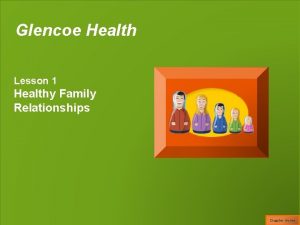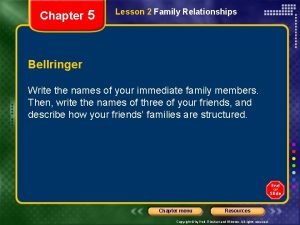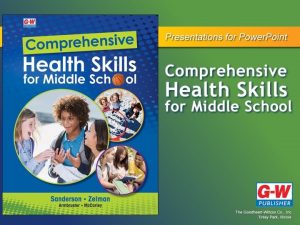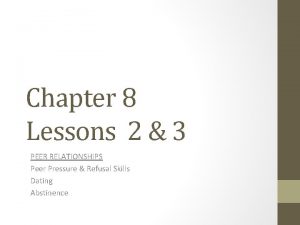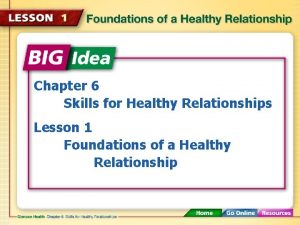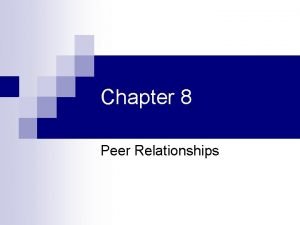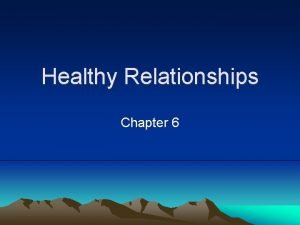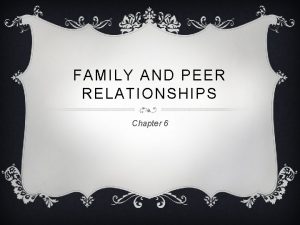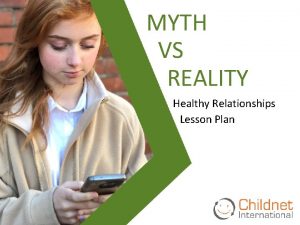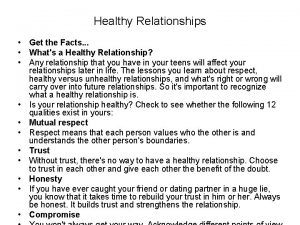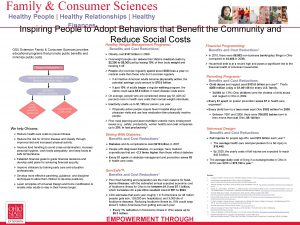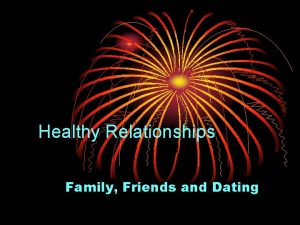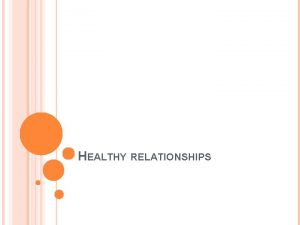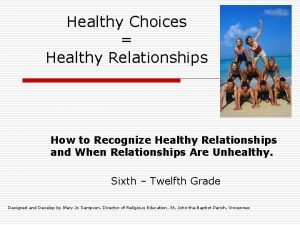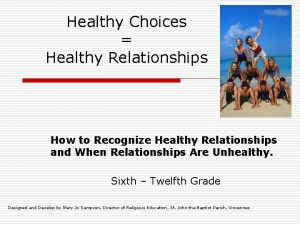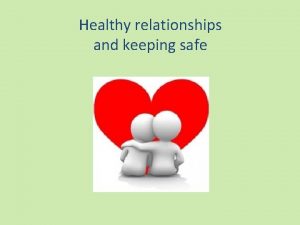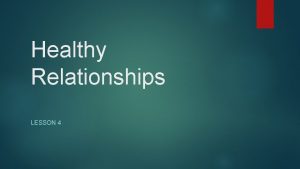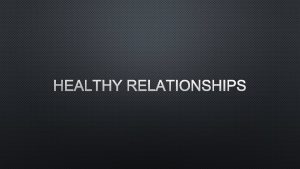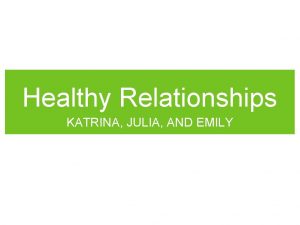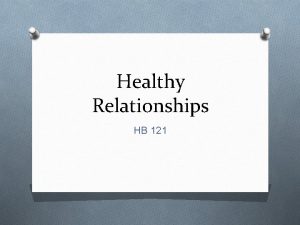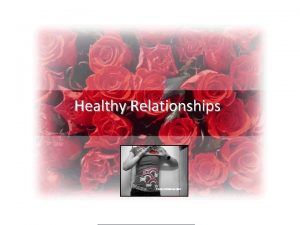Health Chapter 7 Family Relationships Healthy Family Relationships

















- Slides: 17

Health – Chapter 7 Family Relationships

Healthy Family Relationships There a variety of family types with each member having certain responsibilities n Family relationships have a strong influence on your total health n Being part of a strong family can also be a protective factor for teens by helping them avoid behaviors that may put them at risk n

Healthy Family Relationships n Types of families… n n n Single-parent Blended (includes married couple and child/ren from previous marriage/s) Extended (includes additional relatives beyond parents and children) Adoptive Foster (temporary placement of children in homes of adults who are not related to them)

Healthy Family Relationships Siblings – brothers and sisters n Nuclear family – two parents and one or more children living in the same place n Roles in the family unit… n n n Parents/guardians – provide basic needs and serve as a “teacher” (establishing rules/behaviors) to prepare them for the future Children – respecting parental authority, helping out (e. g. chores), etc.

Healthy Family Relationships Your family members contribute significantly to your overall health n Physical n n n Providing basic needs (food/shelter/water) Providing medical care (e. g. doctor visits and immunizations) Setting limits on behavior (e. g. curfews) Teaching health skills (e. g. safety skills, healthy eating, exercising)

Healthy Family Relationships n Mental/Emotional Health n n n Safe environment for expressing and dealing with emotions Giving you love and support (“feeling of belonging”) Affirmation – positive feedback that helps others feel appreciated and supported

Healthy Family Relationships n Social n n Help you learn how to communicate with others How to cooperate with others and problem solve Values (responsibility/honesty/respect) and cultural heritage *Your family both directly and indirectly affects all aspects of your health triangle

Strengthening Family Relationships n Traits of strong families include… n n n Good communication Caring and support Respect (for opinions, tastes, abilities, and possessions) Commitment (making time for one another and sticking together to solve problems) Trust

Strengthening Family Relationships Families can face a variety of problems (both major and minor) n Since change is an normal part of life, healthy families must be prepared to deal with changes and help one another cope n These problems are often a result of changes in family structure or circumstances n

Strengthening Family Relationships n Changes in family structure (when someone new joins or someone leaves the home) n n Birth/adoption Separation (decision by two married people to live apart) and divorce (legal end to a marriage contract) n n n *custody – the legal right to make decisions affecting children and the responsibility for their care (sole or joint) Remarriage Death of a family member (typically the most difficult change)

Strengthening Family Relationships n Changes in family circumstances n n Moving to a new home/school/etc. Changes in a family’s financial situation (e. g. job loss, medical emergency, poor planning, uncontrolled spending) Illness & disability Alcohol or other drug use/abuse

Strengthening Family Relationships n Coping with changes… n n n One of the most important strategies is to talk honestly and openly with one another Make an effort to support your family where possible If needed, look for help outside of the family (e. g. counselors, teachers, etc. )

Help for Families One of the most dangerous problems a family can face is abuse (physical, mental/emotional, and/or sexual mistreatment of one person by another) n When this abuse results in acts of violence involving family members, it is considered domestic violence n

Help for Families n Types of abuse include (not limited to)… n n Spousal – directed at a spouse Child – includes any action that harms or threatens a child’s development n n Elder – abuse/neglect of older family members n n *neglect – failure to provide for a child’s basic needs (food, clothing, shelter, support, etc. ) Can occur both in the home and in institutions (and can also be financial) These types of abuse can all be physical, mental/emotional, and/or sexual in nature

Help for Families n Effects of abuse can include physical harm (e. g. broken bones) as well as permanent mental/emotional damage n n Repeated abuse/violence over time is called the cycle of violence Individuals suffering from abuse need to talk to someone they trust

Help for Families n The Three R’s (for stopping domestic violence) n n Recognize the problem Resist abusers as best as possible Report the abuse to someone who can help Common forms of support for those families in crisis include… n n n Family counseling services Support groups Community services (hotlines or shelters) Law enforcement officials Hospitals or clinics

Questions for Thought Four ways families promote physical health? n How can families demonstrate good communication? n What are some situations that can lead to changes in family structure? Circumstances? n What are four different types of child abuse? n Give an example of an abusive situation and how that person might go about getting help. n
 Glencoe health chapter 7
Glencoe health chapter 7 Chapter 7 lesson 1 healthy family relationships
Chapter 7 lesson 1 healthy family relationships Close family chapter 5
Close family chapter 5 Define the relationship chapter 14
Define the relationship chapter 14 Strong relationships
Strong relationships Chapter 8 lesson 1 safe and healthy friendships
Chapter 8 lesson 1 safe and healthy friendships Chapter 6 skills for healthy relationships lesson 1
Chapter 6 skills for healthy relationships lesson 1 Friendly relationship chapter 8
Friendly relationship chapter 8 Define the relationship ch 6
Define the relationship ch 6 Friendly relationship chapter 6
Friendly relationship chapter 6 Healthy food healthy mind journal
Healthy food healthy mind journal Healthy soil healthy life poster ideas
Healthy soil healthy life poster ideas Healthy forests healthy communities poster contest
Healthy forests healthy communities poster contest Healthy nurse healthy nation
Healthy nurse healthy nation Relationship in jeopardy meaning
Relationship in jeopardy meaning Healthy relationships lesson plan
Healthy relationships lesson plan Healthy vs unhealthy relationships scenarios
Healthy vs unhealthy relationships scenarios Healthy relationship facts
Healthy relationship facts
